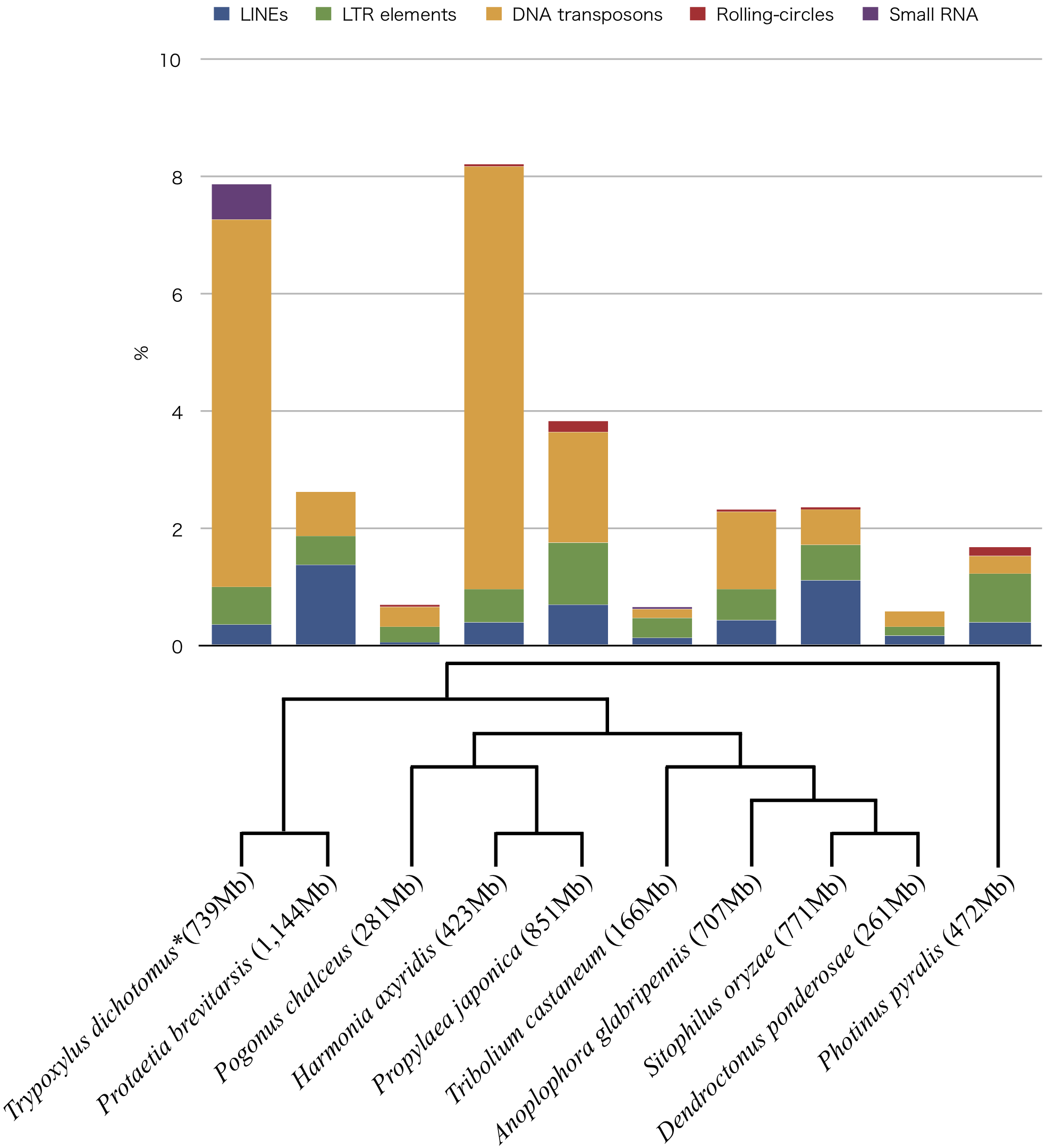Abstract
The draft whole-genome sequence of the Japanese rhinoceros beetle, Trypoxylus dichotomus was obtained using long-read PacBio sequence technology. The final assembled genome consisted of 739 Mbp in 2,347 contigs, with 24.5× mean coverage and a G+C content of 35.99%.
Description
Genomic research of the Japanese rhinoceros beetle, Trypoxylus dichotomus has been of interest since their large body size (~35g) and sexual dimorphizm in adult horn, and although several transcriptome studies had been conducted (Ogata et al., 2017; Ohde et al., 2018; Warren et al., 2014), the genome itself has not yet been deciphered. The haploid chromosome number, n, 10, and the male heterogamety of XY-type established for the beetle are known (Kudoh et al., 1970). Here we sequenced and assembled the genome of the beetle. Last-instar female larvae were harvested at Fuchu-shi, Tokyo, Japan and reared in leaf mold. Larval fat bodies were isolated. Total DNA was extracted from the fat bodies using the Qiagen Blood & Cell Culture DNA Maxi Kit (Qiagen, Gaithersburg, MD). Isopropanol and the eluted DNA mixture were dispensed to 1.5 mL tube at the step of centrifuging DNA for making pellet. DNA shearing performed using Megaruptor® 3 (Diagenode, Liège, Belgium), targeting an average fragment size of 20 kb. The SMRTbell Express template preparation kit 2.0 (Pacific Biosciences, Menlo Park, CA) and the Barcoded Overhang Adapter Kit (Pacific Biosciences) were used to ligate hairpin adapters required for sequencing to the fragmented DNA. The library was size selected using the SageELF (Sage Science, Beverly, MA) and the 0.75% Agarose DNA ELF cassette with marker 75 (Sage Science). Sequence template was prepared by Sequel Ⅱ Binding Kit 2.0 (Pacific Biosciences) and Sequel Ⅱ DNA Internal Control Kit 1.0 (Pacific Bio-sciences). Sequencing was done on the Sequel Ⅱ System (Pacific Biosciences) using Sequel Ⅱ Sequencing Kit 2.0 (Pacific Biosciences) and Sequel SMRT Cell Oil (Pacific Biosciences). Data processing was performed using SMRT Link v8.0.0 (Pacific Biosciences). In total, 18,816,210,693 bp, 1,363,523 reads were generated as CCS reads. The G+C content of the beetle genome was 35.99%. Library preparation and sequencing were performed at the Takara Bio Inc. (Kusatsu, Shiga, Japan). Reads were trimmed, corrected, and assembled using the Hifiasm software version 0.3.0 (Gheng et al., 2020). The final assembled genome consisted of 739,405,423 bp in 2,347 contigs, with 24.5× mean coverage. The largest contig size was 36,507,117 bp. The N50 of the contigs was 7,929,129 bases. The genome was annotated using public transcriptome data (DRA004723 and DRA006307), hisat2 (Kim et al., 2019) and cufflinks (Trapnell et al., 2010). The mapped rate of sequence data DRA004723 to the genome was 94%. The transcripts number was 34,598. For the genomic sequence, 99.6% of the BUSCO orthologs were detected as complete sequences, 0.1% were fragmented and 0.3% were missing (-l option was insecta_odb10) (Simão et al., 2015). The interspersed repeats and low complexity DNA sequences in the genome were screened using RepeatMasker (Smit et al., 2015). LINEs, LTR elements, DNA transposons, and small RNAs occupied 0.36%, 0.64%, 6.28%, and 0.61% of the genome, respectively. The genome of Trypoxylus dichotomus showed more small RNAs than other Coleopteran genomes (Protaetia brevitarsis (GCA_004143645.1), Pogonus chalceus (GCA_002278615.1), Harmonia axyridis (GCA_003402655.1) (Ando et al., 2018), Propylaea japonica (GCA_013421045.1) (Zhang et al., 2020), (Tribolium castaneum (GCF_000002335.3) (Herndon et al., 2020), Anoplophora glabripennis (GCF_000390285.2), Sitophilus oryzae (GCF_002938485.1), Dendroctonus ponderosae (GCA_000346045.2) (Keeling et al., 2013) and Photinus pyralis (GCF_008802855.1) (Fallon et al., 2018)).
Reagents
This whole-genome shotgun project has been deposited at GenBank under the accession no. BNES00000000.1. Raw reads were deposited at DDBJ SRA under the accession no. DRA010769.
Acknowledgments
We thank Ph.D. Tomoko Matsuda for the selection of the nine beetle genomes and analysis of the repeats, and Ph.D. Shogo Konishi for his help with DNA extraction.
References
Funding
This work was not supported by any grant.
Reviewed By
David Angeles-AlboresHistory
Received: September 15, 2021Revision received: September 27, 2021
Accepted: September 30, 2021
Published: October 11, 2021
Copyright
© 2021 by the authors. This is an open-access article distributed under the terms of the Creative Commons Attribution 4.0 International (CC BY 4.0) License, which permits unrestricted use, distribution, and reproduction in any medium, provided the original author and source are credited.Citation
Ogata, N (2021). Whole-Genome Sequence of the Trypoxylus dichotomus Japanese rhinoceros beetle. microPublication Biology. 10.17912/micropub.biology.000487.Download: RIS BibTeX



